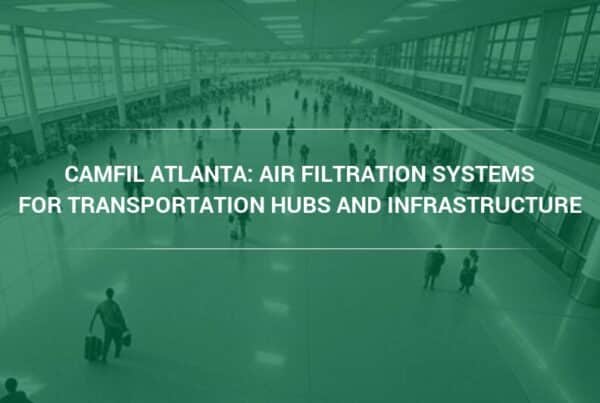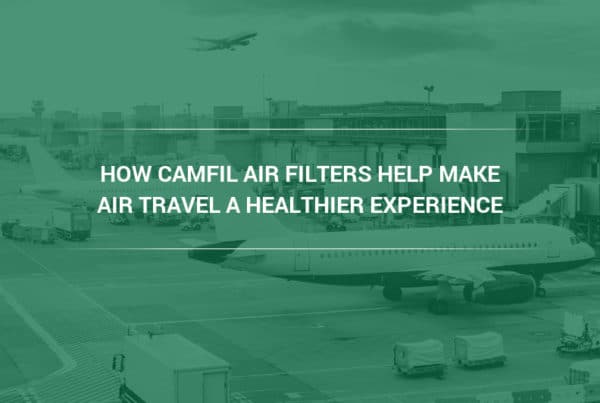Watch Video on YouTube
The comfort of air passengers as they spend time in terminals waiting for flights, booking tickets and dealing with the frustrating aspects of airport security is a major concern for those that design or maintain these facilities.
Although passengers are transient, flight delays can significantly increase terminal occupancy and exposure to contaminants. Airport employees are also deserving of a proper working environment that includes indoor air equivalent to 100% clean outside air.
Airport pollution can come from a wide variety of sources including aircraft engines, auxiliary power units, ground support equipment, ground transport vehicles and of course, contaminants created by the high volume of people moving through the facility. Commercial aircraft use aviation kerosene (jet fuel of Jet A) or an aviation gasoline commonly referred to as Avgas. Auxiliary power units normally burn jet fuel. Ground support unit can include aircraft tugs, start assist units, forklifts, tractors, air-conditioning units, ground power units, baggage tugs, belt loaders, fuel or hydrant trucks, catering trucks, deicer trucks, water trucks, lavatory trucks, and cargo loaders, among others. Contaminants from these units vary depending on the fuel type (e.g., gasoline, diesel, propane, electric, etc.). Passenger shuttles, buses and transport such as taxi cabs and personal vehicle pick-up add to the pollution mix specific to the air surrounding the airport terminal.
The air filtration systems to protect the terminal environment serve double-duty, removal of particulate and removal of gaseous contaminants and odors. Air filter manufacturers have been addressing the unique requirements of these facilities for years using high efficiency particulate air filters and gaseous adsorbers. These filtration technologies have been so successful that the vast majority of terminal occupants rarely express air quality concerns.
The typical filter applied to control particles generated from combustion exhausts, construction, maintenance and the terminal occupants is a MERV 13 air filter. The MERV number corresponds to a particulate removal efficiency in a rating system developed by the American Society of Heating, Refrigeration and Air Conditioning Engineers.
This level of efficiency removes all visible airborne particles and also removes those that cannot be seen because of their extremely small size. These filters contribute to the overall cleanliness level of the facility as wall staining and other nuisance dusts are eliminated. The most important factor, airborne lung-damaging particles are removed from the air protecting building occupants.
Airports also use adsorber systems, carbon filters of granular blends, to remove the gaseous contaminants from the air. Bio effluent odors from people, fumes from jet fuel, and other gaseous contaminants are adsorbed into the filtration granules and later removed for disposal.
The adsorptive capacity of this type of filtration is so extensive that these filters are usually only serviced once every two to three years. The replaced adsorbent media can also be regenerated and reused contributing as a renewable resource for today’s sustainable initiatives.
With today’s filtration technology it is also possible to address existing airport installations and in almost all cases significantly reduce air filter expenditures. Camfil has published numerous case studies. One in particular notes a filter life extension of over 50% and an increase in airflow of over 300%. Airflow is a significant factor when ensuring improved indoor air quality in any building, but possibly nowhere more important than airport terminals. A copy of their case study is available on their web site www.camfil.us.
Recently there have been some alternative technologies promoted as a filtration alternative to traditional airport air quality maintenance practices. They incorporate electro principle filtration techniques. Before considering this type of filtration two factors should be appraised. Electro principle filtration decreases in efficiency over time; some decrease quite rapidly. Particulate control for the protection of building occupants is the objective and will any efficiency less than a maintained MERV 13 be acceptable, even if that drop in efficiency is intermittent over the life of the filter? An additional claim for this type of filtration is that the electro action will breakdown gaseous contaminants because of the effect of molecular change. The academic concern at present is what effect does the contaminant breakdown have and what is the effect of the resultant gases?
When designing any airport facility it is best to consult with an air filtration professional. Consultants have a value if they have experience and one of the most prominent suppliers to airports worldwide is Camfil. A listing of the locations in the US can be found online as well as additional listings for locations worldwide.



